Ijraset Journal For Research in Applied Science and Engineering Technology
- Home / Ijraset
- On This Page
- Abstract
- Introduction
- Conclusion
- References
- Copyright
Child Immunization System
Authors: Manthan Bhome, Krunal Wani, Adesh Kharge, Shravni Chaube, Supriya Lokhande
DOI Link: https://doi.org/10.22214/ijraset.2023.53325
Certificate: View Certificate
Abstract
We are all aware that children should have their vaccines at the right times, however many parents are unaware of this vaccination because of their hectic lifestyles and some parents\' knowledge. Therefore, the goal of our website is to raise awareness among all parents about the need to make sure that all infants receive their vaccines on schedule. An overall strategy for collecting and keeping each child\'s medical data has been suggested based on their date of birth and in compliance with the approved vaccination schedule. It is suggested that doctors and parents have access to a web application that has the appropriate permissions. Due to the a significant rise in mobile usage, the same is provided in an android-based mobile application. Additionally, parents are often urged to vaccinate their kids on schedule until they are fully protected. Keeping medical records in a standard database can help deliver kids who require excellent and efficient treatment in addition to reducing the need to carry documents.
Introduction
I. INTRODUCTION
Vaccination is the use of antibiotic material (a vaccine) to stimulate a person's immune system to develop adaptive immunity to a pathogen. Vaccines can prevent or reduce morbidity from infection. Vaccination is the most effective method of preventing infectious diseases. Immunity spread by vaccination is largely responsible for eradicating smallpox worldwide and preventing diseases such as polio, measles, and tetanus.
Generally, the artificial induction of immunity works by "priming" the immune system with an "immunogen" to protect against infectious disease. Stimulating an immune response with an infectious agent is called immunization. Immunization involves different ways of administering immunogens. Most vaccines are given by hypodermic injection because they are not reliably absorbed from the gut.
Live polio, some typhoid, and some cholera vaccines are given orally to induce immunity in the gut. Vaccination provides a lasting effect but usually takes several weeks to develop, while passive immunity (the transfer of antibodies) produces an immediate effect. Vaccines work by introducing foreign antigens to the immune system to trigger an immune response, but there are several ways to do this. Four main types are currently in clinical use. Most vaccines are administered via a needle (injection), but some are given via mouth (orally) or nasal spray (nasally).
Immunity (protection) from immunization is similar to immunity from disease, except you get a vaccine instead of acquiring the disease. In India, 2.7 crore children are born each year. An estimated 18.3 million children die before their fifth birthday. Every year, vaccine-preventable diseases kill 5 lakh children in India. Despite the high rate of child deaths from vaccine-preventable diseases, 30 percent of Indian children miss out on the benefits of full immunization every year. That is, approximately 8.9 million children nationwide either receive some vaccines or none. One out of every three children in India does not receive all the vaccines available under the UIP. Five percent of children in urban areas and eight percent in rural areas are deprived of immunization. SMS Cell phones have become an integral part of the modern world, providing human connectivity in a way never before possible. While most cell phones are used for their original intent—making telephone calls wirelessly— these devices are also loaded with other features that are not always used or even ignored. Text messaging is a powerful tool in terms of communication, especially for mobile users. Short Message Service (SMS) enables the sending and receiving of messages between mobile phones. SMS does not limit anyone, regardless of whether they are high-end or low-end mobile phones, for as long as they can send and receive messages. So creating awareness through SMS is an effective way
A. Problems
We know that children should be vaccinated at the right time but due to parents' busy schedules, illiteracy, and lack of awareness about vaccination, many children miss out on vaccination. As a result, the baby does not develop immunity, alternatively, the baby may die, so awareness needs to be created among all parents so that all babies are vaccinated at the right time
II. LITERATURE SURVEY
The above survey of various researchers of different immunization tracking system shows that show the all system can handle the register data effectively and and managed data successfully. Authors focus on track the child medical information history and provide awareness of immunization in people and provide effective system to help for reduce time and send reminder to parents
|
Author/Year of Publication |
Title |
Strength |
Weakness |
|
Aliu Rasaki, Ibrahim Rasheed, Mohammed Amina, Girbo Adamu, Hassan Shina, IJCP-2022 |
Mothers’ preference for routine immunization appointment reminders in Gombe, Gombe State, Nigeria |
mothers’ willingness for immunization reminder were access to personal phone and mothers’ tertiary education |
limited for being a single centre |
|
Armania Rahmawati, Achmad Arifin, Eko Agus Suprayitno IEEE-2022 |
Basic immunization management using mobile base application |
Succefuly Managed schedule and appointment |
Application support only smart phone |
|
Hazrati Zaini, Norshahidatul Ishak, Nur Johari, Hamizan Hamzah, IEEE-2021 |
Evaluation of child immunization schedule application using SUMI |
application had successfully complied with efficiency, affect, helpfulness, controllability, and learnability. |
Required high amount of data to appropriate classification. |
|
Siti Nazazihah Rahmat, Arshad Jamal, Mohammed Hazim Alkawaz, Monica Sangaran IEEE-201 |
Parental Reminder and Planner for Children Vaccination |
Google Backup to prevent the data stored in database from being lost |
System not provide vaccine information to parents. |
|
Nikhita Siringi, Shilpi Sharma, IEEE-2017 |
Child Immunization Using Data Analysis |
help make successful choices that will increase achievement of healthcare organization. |
Various implementing issues are related with data mining |
|
Prabhu RV Shankar, Michael Scott Kelleman, Courtney E McCracken, Claudia R Morris, Harold K Simon, IEEE-2016 |
Real Time Access to Online Immunization Records and its Impact on Tetanus Immunization Coverage in the ED |
improve immunization coverage and reduce unnecessary and duplicate immunization |
Not support Reminder system |
III. METHODOLOGY
A. Proposed System
The figure demonstrates how the child immunization system works. System admin can login using user name and password and after successful login, admin can perform various tasks like add, update and delete health center. Also, a doctor as a user can login to the system with a username and password after his account is created. Doctor tasks include: set location, add and manage workers, manage vaccine details, and generate reports.
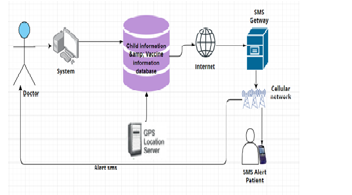
Worker is another user of this system. It uses MySQL software to keep the records in the database which is the best and easiest database to store the information. User filled details are stored in a database. User task include: register new born child, add vaccination, update child record, manage child status, delete child. After filling the database, the system sends an alert a day in advance to the patient's given contact number and alerts the doctor if the patient does not take the vaccine as per schedule.
B. System Architecture
The users of the proposed system are the following– admin, secretary, doctor. They may all make use of the web application, but with specified restrictions and different user interface. The admin’s user
interface will contain the account management as well as managing the doctor’s schedule. The secretary’s user interface will contain the record, schedule management, account management for the patients and report generation. As for the doctor’s interface
e, it will contain the records, schedule management, immunization monitoring and the SMS feature. . Lastly, the patient’s parent contains the profile view of SMS feature and developmental milestones. Internet connection is needed to be able to access the web-application, then all the data will be stored in an database. Figure 1 below shows the System Architecture.
C. Working
Working of Web-Application
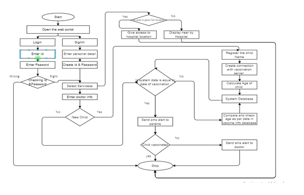
First open the application on the user or administrator computer.
- Then if Doctors or workers are an existing user then login with their appropriate ID and password.
- If you are a new user then Sign in with entering your all details
- After the login process the application dashboard will open where some options are provided for the user like system info, data entry, set location, child search, registration count and feedback form etc.
- Selecting data entry option user will go to the data entry page, here we provided some option for the user, the user can upload their personal data or fill the patient data using child registration option.
- If the child is a new child in the child registry, the user will open the registration form and enter all the required details after which it will create a connection with the vaccination schedule.
- And if the child is already registered, then fill the schedule form of completed vaccine dose.
- Then Logout from web portal.
- The automated system can compare and check the vaccine due date with the schedule and send reminder via text SMS to the patient’s parent’s mobile number a day before, along with complete vaccine information and its pros and cons and with hospital location.
- In case of non-vaccination on the schedule date, the automated system send alert to doctor with complete details of the patient
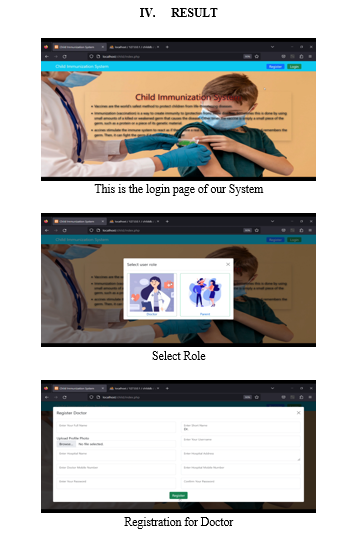
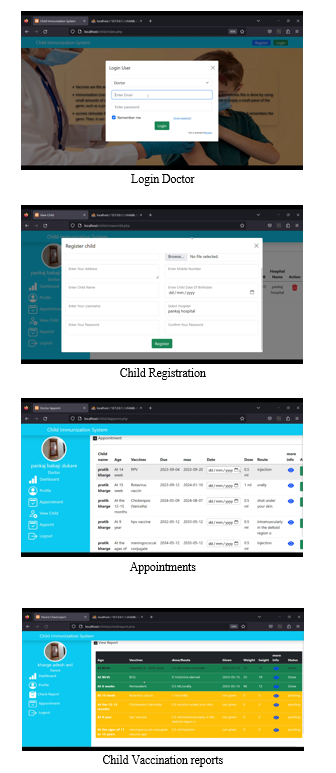
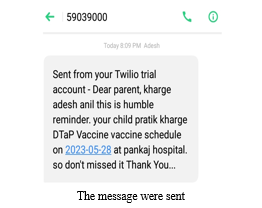
A. System Testing
Once the priorities have been determined, the proponents proceeded with the development. The researchers did a preliminary testing that determined the systems capabilities. The following tests were implemented in an orderly manner:
- Unit testing for the individual modules. The proponents tested each and every module that was developed all throughout this phase to check if errors were still present.
- Integration testing of the combined modules to see if there were errors once the modules were combined.
- System testing for the entire system.
- Cross Browser testing to check if the system is compatible and if it works properly using different browsers. Lastly, User Acceptance Testing. The users are the following: administrator, secretaries of the pediatricians per clinic, the pediatricians and the parents of the patient. There are three (3) iterations done. During the first iteration, 60% of the test cases failed and 40% of the test cases passed. The problems that were discovered by the proponents were mostly about input validations and failure to receive text messages from the website. During the second iteration, 40% of the test cases failed and 60% of the test cases passed. The problems that were discovered by the proponents were, again, mostly about input validations, failure to receive text messages from the website, and a security issue caused by exporting a pdf file. As for the third iteration, none of the test cases failed. All issues that were mentioned earlier were resolved by recording the input validations, availing a text messaging service, and replacing the save button in the report generation part to avoid security issues.
Conclusion
Therefore, we have made an effort to assist parents in receiving SMS messages and notifications that provide time-specific information regarding their child\'s vaccination appointment. A baby vaccination program may assist parents in making sure that their children receive their vaccinations on time. This will make it possible to immunize kids against infections and prevent the spread of disease. The scheduler offers a simple method for registering a newborn child as well as for updating, deleting, and searching for any baby\'s information.
References
[1] Alexandria N.Albers, JuthikaThaker,Sophia R.Newcomerab, ”Barriers to and facilitators of early childhood immunization in rural areas of the United States: A systematic review of the literature,”Preventive Medicine Reports Volume 27, June 2022 [2] Arindam Nandia,Anita Shet,”Why vaccines matter: understanding the broader health, economic, and child development benefits of routine vaccination”,Published online: 24 Jan 2020” [3] S. A. Salawu, S. O. Okide, I. I. Umeh, “Implementation Of Web-Based Architecture For Child Immunization Information Management System Integrated With SMS Reminder” [4] Sourabh Shastri,Anand Sharma ,Prof. Vibhakar Mansotra,”Child Immunization Coverage – A Critical Review”,IOSR Journal of Computer Engineering (IOSRJCE) ,Volume 18, Issue 5, Ver. IV (Sep. - Oct. 2016), PP 48-53,. [5] Central Bureau of Health Intelligence, Government of India. National Health Profile (NHP) of India - 2019. New Delhi: 2019. [6] World Health Organization. World Health Organization: 10 facts on immunization; 2018 [accessed 2019 Apr 9]. https://www.who.int/features/factfiles/immunization/en/
Copyright
Copyright © 2023 Manthan Bhome, Krunal Wani, Adesh Kharge, Shravni Chaube, Supriya Lokhande. This is an open access article distributed under the Creative Commons Attribution License, which permits unrestricted use, distribution, and reproduction in any medium, provided the original work is properly cited.

Download Paper
Paper Id : IJRASET53325
Publish Date : 2023-05-29
ISSN : 2321-9653
Publisher Name : IJRASET
DOI Link : Click Here
 Submit Paper Online
Submit Paper Online

